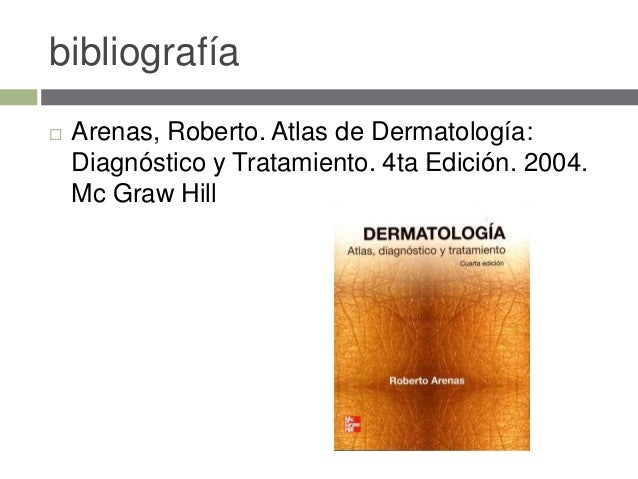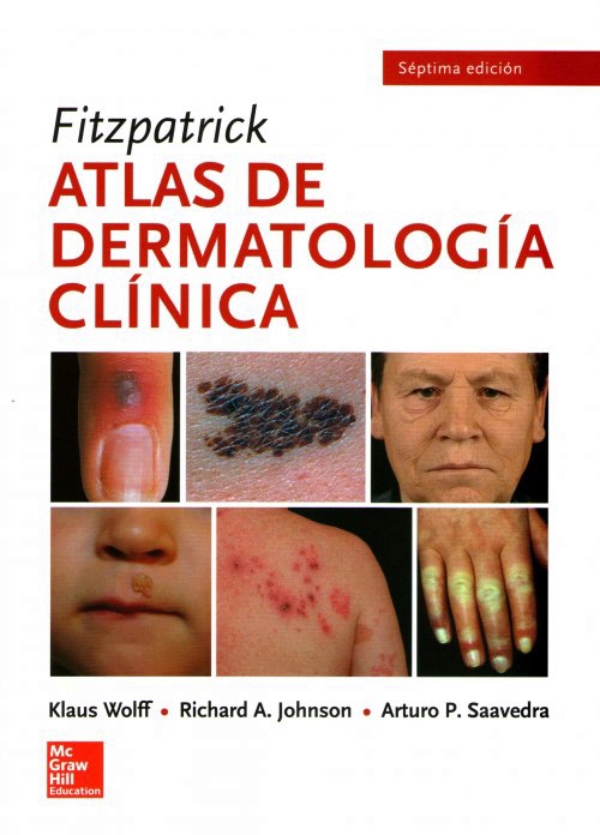Roberto Arenas Atlas De Dermatologia Pdf
Posted By admin On 12/05/19Atlas de dermatologia roberto arenas pdf - File size: 1538 Kb Version: 7.9 Date added: 3 Jun 2014 Price: Free Operating systems: Windows XP/Vista/7/8/10 MacOS Downloads: 1303 DOWNLOAD NOW Contribuciones. Dermatologia atlas diagnostico y tratamiento roberto arenas pdf dermatologia atlas diagnostico y tratamiento roberto arenas pdf examen unico.
- Moreno G, Arenas R. Other fungi causing onychomycosis. Articles from Anais Brasileiros de Dermatologia are provided here courtesy of Sociedade Brasileira.
- Dermatologia atlas diagnostico y tratamiento roberto arenas pdf Dermatologia atlas diagnostico y tratamiento roberto arenas pdf Examen Unico de Residentado Medico.
Abstract
BACKGROUND:

Onychomycosis are caused by dermatophytes and Candida, but rarely by non-dermatophyte molds. These opportunistic agents are filamentous fungi found as soiland plant pathogens.
OBJECTIVES:
To determine the frequency of opportunistic molds in onychomycosis.
METHODS:
A retrospective analysis of 4,220 cases with onychomycosis, diagnosed in a39-month period at the Institute of Dermatology and Skin surgery 'Prof. Dr.Fernando A. Cordero C.' in Guatemala City, and confirmed with a positive KOH testand culture.
RESULTS:
32 cases (0.76%) of onychomycosis caused by opportunistic molds were confirmed.The most affected age group ranged from 41 to 65 years (15 patients, 46.9%) andfemales were more commonly affected (21 cases, 65.6%) than males. Lateral anddistal subungual onychomycosis (OSD-L) was detected in 20 cases (62.5%). Themicroscopic examination with KOH showed filaments in 19 cases (59.4%),dermatophytoma in 9 cases (28.1%), spores in 2 cases (6.25%),and filaments and spores in 2 cases (6.25%). Etiologic agents: Aspergillussp., 11 cases (34.4%); Scopulariopsisbrevicaulis, 8 cases (25.0%); Cladosporium sp., 3cases (9.4%); Acremonium sp., 2 cases (6.25%);Paecilomyces sp., 2 cases (6.25%); Tritirachiumoryzae, 2 cases (6.25%); Fusarium sp.,Phialophora sp., Rhizopus sp. and Alternariaalternate, 1 case (3.1%) each.
CONCLUSIONS:
We found onychomycosis by opportunistic molds in 0.76% of the cases and DLSO waspresent in 62.5%. The most frequent isolated etiological agents were:Aspergillus sp. and Scopulariopsisbrevicaulis.
INTRODUCTION
The term onychomycosis is derived from the Greek words onychos (meaningnail) and mycosis (meaning fungal infection). 1
The nomenclature of fungal infections proposed by the International Society for Humanand Animal Mycology suggest that the term onychomycosis should be replaced: by tineaunguium, when the etiological agent is a dermatophyte; by onyxis, when yeasts are thecause; by ungual candidiasis, when the agent is Candida; and by ungualmycosis if the causal agent is an opportunistic mold. 1
It is difficult to establish the pathogenicity of opportunistic, non-dermatophyte moldson nails, as in all opportunistic infections. There are always a number of criteria thatneed to be fulfilled. The culture must be free of dermatophytes and the opportunisticmold should be observed in the microscopic examination using 10 to 40% potassiumhydroxide (KOH). 2
Opportunistic non-dermatophyte molds (NDM) are found in nature as soil saprophytes andplant pathogens. They are fast growing, have universal distribution and are oftenunnoticed laboratory contaminants.3
The most commonly described species of NDM are: Scopulariopsis brevicaulis,Fusarium sp., Acremonium sp., Aspergillussp., Scytalidium sp. and Onychocola canadienses. 3 A wide group of NDM species and some saprophyteyeast may also affect the nail plate directly. These include some species of the generaAlternaria, Curvularia, Trichosporon and Hendersonula.4
Onychomycosis is the most difficult to treat superficial mycosis. It is a chronicinfection that is prone to relapse. Therefore, it is important to identify the causativeagent to ensure that the appropriate treatment is employed for each case.5
MATERIALS AND METHODS
In the interest of determining the frequency of onychomycosis by opportunistic NDM, aretrospective study was carried out from July 2008 to September 2011 at the Institute ofDermatology and Skin surgery 'Prof. Dr. Fernando A. Cordero C.', in Guatemala City.
A total of 4,220 cases of onychomycosis were studied in that period, and 32 cases(0.76%) were diagnosed as onychomycosis by NDM.
Atlas De Dermatologia Virtual
We reviewed the data collected in the Medical Mycology Unit of the Institution, andanalyzed the following variables: sex, age, residence, history, associated diseases,clinical type, localization, mycological study with KOH and culture.
RESULTS
Of a total of 4,220 onychomycosis cases diagnosed in a 39-month period, 32 wereconfirmed as onychomycosis caused by opportunistic molds (0.76%).
During data analysis, a predominance of females was observed (21 cases, 65.63%). (Graph 1). The most affected age group was 41-65 years(15 patients, 46.9%), followed by 18-40 years (12 patients, 37.5%), older than 65 years(4 patients, 12.5%) and 0-17 years (3.1%).

Distribution of patients by gender
With regard to the place of residence, 6 cases (18.7%) lived in the rural area and 26cases (81.3%) lived in the urban area. History of clinical manifestations varied from 1month to 30 years, with an average of 7 years (Table1). Regarding to the clinical form, distal and lateral subungual onychomycosis(DLSO) predominated, accounting for 20 cases (62.5%), followed by total dystrophiconychomycosis (TDO), which accounted for 12 cases (37.5%) (Graph 2).
TABLE 1
| Variables | ||
|---|---|---|
| Gender | ||
| Female | 21 | 65.63% |
| Male | 11 | 34.37% |
| Age | ||
| 0-17 | 1 | 3.1% |
| 18-40 | 12 | 37.5% |
| 41-65 | 15 | 46.9% |
| >65 | 4 | 12.5% |
| Duration | ||
| Shorter | 1 Month | |
| Longer | 30 Years | |
| Average | 7.02 Years | |
| Clinical Form | ||
| Dlso | 20 | 62.5% |
| Tdo | 12 | 37.5% |
Distribution according to clinical form
We also found a predominance of toenail involvement, which accounted for 30 cases(93.75%). There were only 2 cases of fingernail onychomycosis (6.25%). The mycologicalstudy with KOH was positive for filaments in 19 cases (59.4%), for dermatophytoma in 9cases (28.1%), for spores in 2 cases (6.25%) and for filaments and spores in 2 cases(6.25%).
The following etiologic agents were identified: Aspergillus sp., n=11cases (34.4%); Scopulariopsis brevicaulis, n=8 cases (25.0%);Cladosporium sp., n=3 cases (9.4%); Acremonium sp.,n=2 cases (6.25%); Paecilomyces sp., n=2 cases (6.25%);Tritirachium oryzae, n= 2 cases (6.25%); Fusariumsp., n=1 cases (3.1%); Phialophora sp, n= 1 case (3.1%);Rhizopus sp, n= 1 case (3.1%); and Alternaria alternata, n=1 case(3.1%) (Table 2). It is noteworthy that 3control cultures were performed in each case, confirming the results described above.Patients' occupation: 46.9% (n=15) were housewives and 12,5% (n=4) were students.
TABLE 2
| ETIOLOGIC AGENT | Number of cases | Frequency % |
|---|---|---|
| Aspergillus sp | 11 | 34.4% |
| Scopulariopsis brevicaulis | 8 | 25.0% |
| Cladosporium sp | 3 | 9.40% |
| Acremonium sp | 2 | 6.25% |
| Paecilomyces sp | 2 | 6.25% |
| Tritirachium oryzae | 2 | 6.25% |
| Fusarium sp | 1 | 3.10% |
| Phialophora sp | 1 | 3.10% |
| Rhizopus sp | 1 | 3.10% |
| Alternaria alternata | 1 | 3.10% |
| Total | 32 | 100% |
DISCUSSION
According to Crespo et al., the isolation rates of opportunistic NDM in nails range from2 to 25%.2 However, it should be noted that theprevalence of onychomycosis caused by molds in the general population is unknown, sinceall published studies are conducted in selected populations with patients with naildystrophy or clinical suspicion of onychomycosis attending to dermatologicalconsultation or clinical laboratories.6
The data collected over a period of 39 months at the Institute of Dermatology and Skinsurgery 'Prof. Dr. Fernando A. Cordero C.', in Guatemala City, showed an incidence of0.76% of onychomycosis caused by opportunistic NDM, which is between the ranges reportedin other studies.
It is necessary to use direct microscopic examination and culture in the study ofonychomycosis for the identification of the etiologic agent.7 The direct microscopic examination is performed with 10 to 40%potassium hydroxide; this helps to dissolve keratin for visualization of fungalmaterial. The morphology of hyphae will show the probably fungal etiology: regularhyphae indicate dermatophytes and irregular hyphae give suspicion of NDM. Abasti et al.state that at least two successive cultures must be performed to check the initialdiagnosis.3 In our study, data werecorroborated by 3 additional cultures.
Some factors predispose to the development of fungal infections and they may be helpfulin understanding the results of the cultures, such as: patient origin, work environment,exposure to affected human or animals.4
Onychomycoses caused by Candida are closely related to work activitiesthat require frequent water immersion of hands. Abasti et al. found a higher frequencyof onychomycosis caused by opportunistic NDM in housewives.3
The five most common organisms worldwide are: Scopulariopsis brevicaulis,Fusarium sp., Aspergillus sp., Scytalidium dimidiatum and Acremonium sp.. InColombia (South America), there are studies suggesting the Fusariumspecies as the most common.8,9 In European countries, the most frequent speciesare: Scopulariopsis brevicaulis, Aspergillus sp.,Acremonium sp. and Fusarium sp. 10 The species found in this study were:Aspergillus sp., Scopulariopsis brevicaulis,Cladosporium sp., Acremonium sp., andPaecilomyces sp..
It is noteworthy that onychomycoses are more common in the first toes of people over 60years of age, with peripheral vascular disease, anatomical alterations, nail pathologyand endocrine diseases.2 The toenails was themost affected anatomic area in this study, with a total of 30 cases (93.75%). There wereonly 2 cases in the fingernails (6.25%). Escobar et al.8 observed a predominance of onychomycosis of toenails in female patients(62%) aged 21 to 50 years (91%).11 Similarresults were found in the present study, with 21 cases (65.63%) in females and 11 casesin males (46.9%). The most affected age group was 41 to 65 years, with 15 patients(46.9%).
Roberts et al. described four clinical forms for dermatophytes and other filamentousfungi: distal and lateral subungual onychomycosis (DLSO), white superficialonychomycosis (WSO), proximal subungual onychomycosis (PSO) and total dystrophiconychomycosis (TDO).12 The most common variant isthe DLSO, and it is basically caused by dermatophytes, mainly T.rubrum. The WSO is less common than the DLSO and is related toimmunosuppression.13 Elewski et al. estimatethat about 10% of onychomycosis are presented under this clinical form; it is morefrequent in toenails and especially in the first toe.14T. mentagrophytes varinterdigitale is the most commoncausative agent of WSO, but may be caused by other opportunistic molds such as:Aspergillus terreus, Acremoniun potronii and Fusariumoxysporum.11,15 The PSO is a rare clinical form, mostly caused by T.rubrum, which equally affects fingernails and toenails. TDO is the finalstage of onychomycosis; there is an involvement of the nail matrix and the entire nailis destroyed, appearing friable keratotic masses.13 The data collected in our study show a predominance of DLSO (62.5%),followed by total dystrophic onychomycosis (TDO) (37.5%).
The diagnostic criteria necessary to detect onychomycosis caused by opportunistic moldsshould be fulfilled, in order to ensure adequate treatment. This is because thetherapeutic management of onychomycosis by filamentous fungi non-dermatophytic iscomplex and unsatisfactory and much more difficult than that of tineaunguium.6,16
CONCLUSION
Most of our findings are similar to other studies and it is worth noting that it isimportant to make a complete mycological study (microscopic examination with KOH andculture) in patients with suspicion of onychomycosis.
Footnotes
Financial Support: Institute of Dermatology and skin surgery “Prof. Dr. Fernando A.Cordero C.”, Guatemala City, Guatemala.
Conflict of Interest: None.
How to cite this article: Marinez-Herrera EO, Arroyo-Camarena S,Tejeda-García DL,Porras-Lopez CF, Arenas R. Onychomycosis due to opportunistic molds. An BrasDermatol. 2015;90(3):334-7.
*Study conducted at the Institute of Dermatology and skin surgery “Prof. Dr. FernandoA. Cordero C.”, Guatemala City, Guatemala.
Reference
Roberto Arenas Atlas De Dermatologia Pdf
